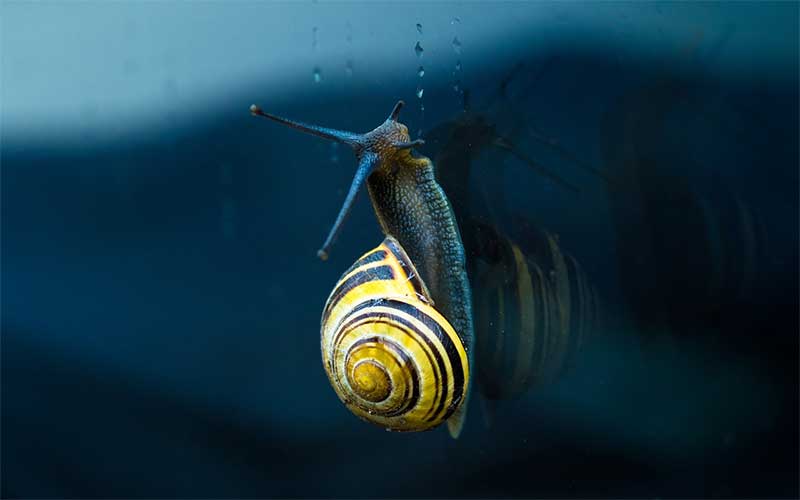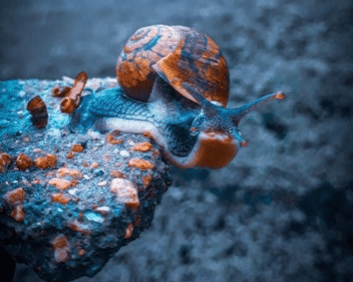Snail Dangers and Predators
Land snails have a large number of predators. They are small animals, slow, and lack agility or physical defense skills. For these reasons, they are the prey of other bigger, stronger and faster animals. From the ecological point of view, land snails are at the bottom of the food chain.
The most common enemies of land snails are small vertebrates, invertebrates, birds, and mammals. They are not usually victims of large animals. Among the predators are flies, mites, nematodes, millipedes, centipedes, some caterpillars and fireflies, leeches, beetles and their larvae, rats, mice, weasels, squirrels, toads, salamanders, turtles, blackbirds, wild turkeys and other Birds of the subfamily Tetraoninae.
And they also eat each other. Well, in some cases. Certain species such as the Rumina conch shell enjoy eating other relatives, usually garden snails (Helix aspersa). Haplotrema concavum is an American carnivorous predator snail that, in addition to worms, enjoys eating other snails that may be of the same species. Many of the smaller species of snails end up eaten by larger ones like the Decollate snail, which is a voracious predator that feeds on garden snails and slugs as well as their eggs.
Predators attack snails according to their size and capabilities.
Predators attack snails according to their size and capabilities. For the smaller ones, like nematodes or larvae, it is relatively easy to enter by the opening of the shell and begin eating the snail. The bigger ones can crush them or make a hole in the shell to extract the soft body.
In some cases, snails are victims of predators introduced into their habitat, that is, animals that do not belong to their natural environment which can be very dangerous for them. Look at what has happened to the snail species Pseudocharopa whiteleggei, highly vulnerable to the black rat (Rattus rattus) introduced in Australia in the early twentieth century. This black rat has been key to the decline of the population of this species of snail.
In residential areas, pets can be predators for snails as well. They include cats and dogs. They may not need to consume them as food, but they are often curious as well as territorial. Some may eat them, but others simply kill them or just play with them.
Some snails have more predators than others, either because of their physical characteristics or the habitat in which they live. Species of the genus Powelliphanta (native of New Zealand), although they are carnivorous and can eat other snails, must take care of opossums, rats, weasels, pigs, wekas (Gallirallus australis), song thrushes (Turdus philomelos), hedgehogs and weasels.
How do snails defend themselves?
They may not look the most ferocious, but they are not completely defenseless against their predators either. To do this, they can use strategies such as the following:
– They retract into their shells.
As we know, they are not fast; Then, when they feel danger nearby, they lock themselves into their shell and cover the opening with a layer of mucus called epiphragm.
– They secrete extra mucus.
When an animal attacks a snail, it releases large amounts of mucus, perhaps to confuse or stifle the attacker. So far, it is not confirmed if the secretions of land snails contain toxic substances.
– They hide beneath the ground.
It is always effective to disappear from the sight of your predator.
– Live in areas with places to hide like rocks and plants.
Some dwell in places difficult to access like cracks or crevices or in the ceilings of some structures.
– Cryptic coloring.
The shell of most snails is brown or light brown, which sometimes makes them hard to see on the ground or in the trunks of trees.
– Flee!
Some snails prefer to escape from a direct attack. They can move swiftly if another snail is on top of them. Some manage to do it without their attacker noticing.
Their consumption is common, and millions are captured and consumed for food annually.
Human Danger
Humans are a huge threat to some snail species. Their consumption is common, and millions are captured and consumed for food annually. However, most snails used for food grow on farms, so the wild population isn’t threatened.
With so many predators you may wonder how the snails continue to survive. The fact that they can mate several times per year is very helpful; they can lay up to 100 eggs at a time which is another advantage. Even though they have a high mortality rate, their reproduction ratio is adequate to keep the number of snails suitable for survival.
Many experts feel that the abundance of snails helps to keep other types of animals thriving as well. As you can see from the list of predators above, there is a lot of animals that can benefit from eating these mollusks.
Sources:
http://www.carnegiemnh.org/science/default.aspx?id=16822
https://en.wikipedia.org/wiki/Land_snail#Predators
http://www.carnegiemnh.org/science/mollusks/predators.html
BioExpedition Publishing © 2017.







